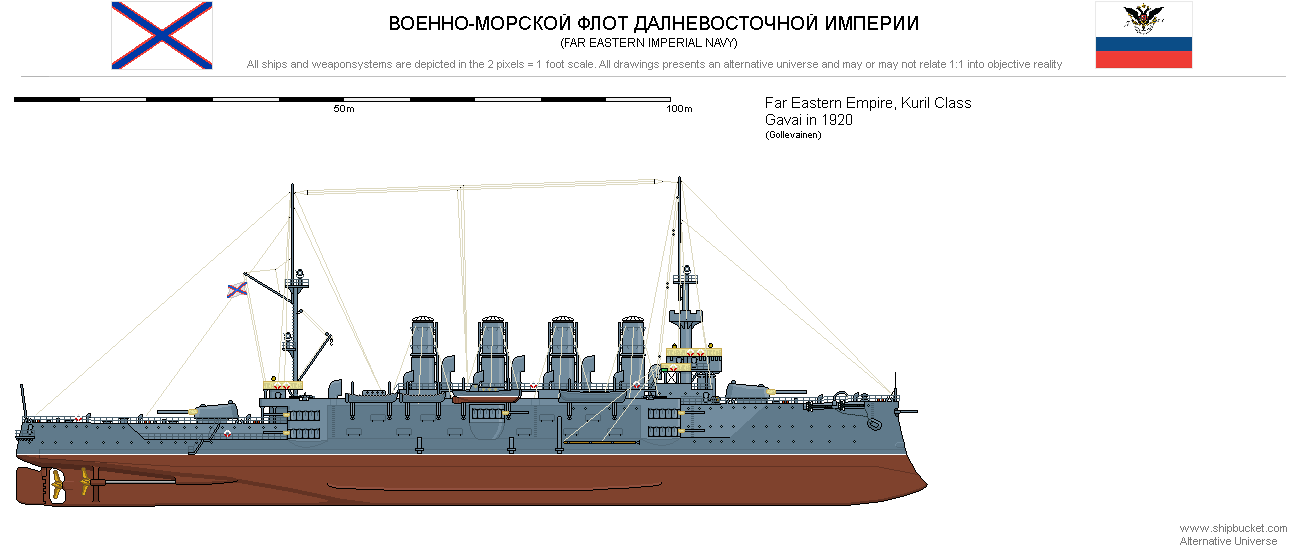Kuril class Armored Cruiser
| Kuril class Armored Cruiser | |
|---|---|
| Class overview | |
| Name | Kuril class Armored Cruiser |
| Operators | Far Eastern Imperial Navy |
| Planned | 4 |
| Built | 4 |
| Active | 3 |
| Destroyed | 1 |
| General Characteristics | |
| Type | Armored cruiser |
| Displacement |
|
| Length | 139.0 metres (456.0 ft) |
| Beam | 19.38 metres (63.6 ft) |
| Draught | 7.63 metres (25.0 ft) |
| Propulsion | 3 shafts, 3 VTE steam engines |
| Power |
|
| Speed | 21 kts |
| Range | 8500 nm at 10 kts |
| Complement | 752 |
| Armament |
|
| Armour |
|
Development
Although the main naval strategy had switched towards battleship-oriented battle-squadrons, it was still thought that series of armored cruisers would be needed to make the Light Squadron full strength of 8 modern armored cruisers. The new ships were the first break off from the french-influenced designs. The tumblehome hull form was reduced considerably and secondary armament was moved into casemates. This was partly after operational experience had showed that the turreted secondaries in the earlier ships had slower response and firing rates than casemate guns. This experience was later confirmed in the Far Eastern - Japanese war. Main reason was however reducing weight. Overall the ships were somewhat smaller than their predecessors. The unique single 152mm gun was retained in the bow.
Building these ships was criticized from the beginning and that critic grew louder in hindsight after the Far Eastern - Japanese war. It was said that the commercial raiding cruisers just ate too much room and resources from the battleship construction and with the money spend on these ships would allowed 1 or 2 more battleships being build.
Even during the construction of these ships the role of armored cruisers begun transition from the commercial raiding role into more combined fleet operations. Far Eastern Empire followed closely Japanese fleet expansion program and took notice of Japanese idea of using Armored cruisers as organic part of the battlefleet. This idea begun to interest Far Eastern naval planners as well. After completion these ships occasionally operated with the 1st Squadron. However when the Far Eastern-Japanese war started, only Alyaska and Kuril were assigned into the 1st Squadron. Kuril escaped the Japanese blockade after the Battle of Yellow sea together with the Battleship Imperiya and were interned in China for the rest of the war. Alyaska was sunk in the battle of Tsusima in 1905.
Ships in class
| Name | Builder | Laid down | Launch Date | Entered Service | Fate |
|---|---|---|---|---|---|
| Kuril | Novaya Verf, Dalny | February 1899 | July 1900 | April 1902 | Extant in 1920 |
| Alyaska | Novaya Verf, Dalny | February 1899 | July 1900 | May 1902 | Sunk in 1905 |
| Gavai | Admiralteyskiye verf, Vladivostok | June 1899 | September 1900 | August 1902 | Extant in 1920 |
| Sakhalin | Admiralteyskiye verf, Vladivostok | June 1899 | September 1900 | August 1902 | Extant in 1920 |
